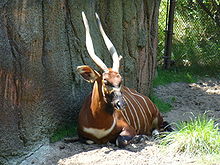London Zoo, previously known as ZSL London Zoo or London Zoological Gardens and sometimes called Regent's Park Zoo, is the world's oldest scientific zoo. It was opened in London on 27 April 1828, and was originally intended to be used as a collection for scientific study. In 1831 or 1832, the animals of the Tower of London menagerie were transferred to the zoo's collection. It was opened to the public in 1847. As of December 2022, it houses a collection of 14,926 individuals, making it one of the largest collections in the United Kingdom.
The Saint Louis Zoo, officially known as the Saint Louis Zoological Park, is a zoo in Forest Park, St. Louis, Missouri. It is recognized as a leading zoo in animal management, research, conservation, and education. The zoo is accredited by the Association of Zoos and Aquariums (AZA). Admission is free based on a public subsidy from a cultural tax district, the Metropolitan Zoological Park and Museum District (ZMD); fees are charged for some special attractions. A special feature is the 2 ft narrow-gauge Emerson Zooline Railroad with passenger trains pulled by Chance Rides C.P. Huntington locomotives that encircle the zoo, stopping at the more popular attractions.

The San Diego Zoo is a zoo in Balboa Park, San Diego, California, housing 4,000 animals of more than 650 species and subspecies on 100 acres (40 ha) of Balboa Park leased from the City of San Diego. Its parent organization, San Diego Zoo Wildlife Alliance, is a private nonprofit conservation organization, and has one of the largest zoological membership associations in the world, with more than 250,000 member households and 130,000 child memberships, representing more than a half million people.

The Columbus Zoo and Aquarium is a non-profit zoo located near Powell in Liberty Township, Delaware County, Ohio, United States, north of the city of Columbus. The land lies along the eastern banks of the O'Shaughnessy Reservoir on the Scioto River, at the intersection of Riverside Drive and Powell Road. It has a worldwide reputation, largely attributable to the efforts and promotion of director emeritus Jack Hanna. In 2009, it was named by the USA Travel Guide as the number one zoo in the United States. It was also ranked number one best zoo in 2012 by Besties Readers Choice.

Taronga Zoo is a government-run public zoo located in Sydney, New South Wales, Australia, in the suburb of Mosman, on the shores of Sydney Harbour. The opening hours are between 9:30 a.m. to 4:30 p.m. Taronga is an Aboriginal word meaning "beautiful view".

Omaha's Henry Doorly Zoo and Aquarium is a zoo in Omaha, Nebraska. It is accredited by the Association of Zoos and Aquariums and a member of the World Association of Zoos and Aquariums. In August 2014, TripAdvisor rated it the "world's best zoo", ahead of the San Diego Zoo and Loro Parque, based on an algorithmic assimilation of millions of reviews for 275 major zoos worldwide.

The Oakland Zoo is a zoo located in the Grass Valley neighborhood of Oakland, California, United States. Established on June 6, 1922, it is managed by the Conservation Society of California, a 501(c)(3) non-profit organization dedicated to the conservation of wildlife both locally and globally. The zoo is home to more than 850 native and exotic animals and is a member of the Association of Zoos and Aquariums (AZA).
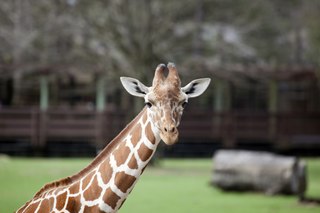
Montgomery Zoo is a 40-acre (16 ha) zoo located on the north side of Montgomery, Alabama. The zoo is an independent city department, and is supported in part by The Montgomery Area Zoolocal Society. It is home to approximately 750 animals representing 140 species. After not renewing their Association of Zoos and Aquariums membership in 2013, the zoo opted to remain accredited solely by the Zoological Association of America. The Mann Wildlife Learning Museum opened in January 2003 and serves as the administration building. The museum features taxidermy displays with a focus on native wildlife, game species, and wildlife management.

The Detroit Zoo is a zoo located in the cities of Huntington Woods and Royal Oak in the U.S. state of Michigan. Spanning 125 acres (50.6 ha), it houses more than 2,000 animals and more than 200 different species. The zoo was the first U.S. zoo to feature bar-less habitats, and is regarded to be an international leader in animal welfare, conservation and sustainability by the Detroit Zoological Society.

The Cleveland Metroparks Zoo is a 183-acre (74 ha) zoo in Cleveland, Ohio. The Zoo is divided into several areas: Australian Adventure; African Savanna; Northern Wilderness Trek, The Primate, Cat & Aquatics Building, Waterfowl Lake, The RainForest, Asian Highlands, and the newly added Susie's Bear Hollow. Cleveland Metroparks Zoo has one of the largest collections of primates in North America, The Zoo is a part of the Cleveland Metroparks system.
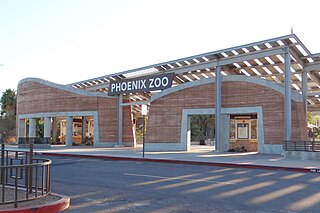
The Phoenix Zoo opened in 1962 and is the largest privately owned, non-profit zoo in the United States. Located in Phoenix, Arizona, the zoo was founded by Robert Maytag, a member of the Maytag family, and operates on 125 acres (51 ha) of land in the Papago Park area of Phoenix. It has been designated as a Phoenix Point of Pride.
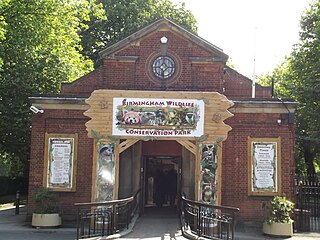
Birmingham Wildlife Conservation Park, formerly Birmingham Nature Centre, and before that Birmingham Zoo, is a small zoo on the edge of Cannon Hill Park in Birmingham, England. It is owned and managed by Birmingham City Council.

Leipzig Zoological Garden, or Leipzig Zoo is a zoo in Leipzig`s district Mitte, Germany. It was first opened on June 9, 1878. It was taken over by the city of Leipzig in 1920 after World War I and now covers about 27 hectares and contains approximately 850 species. By 2020 the zoo featured six different theme worlds, aiming at providing habitats appropriate for the species on display.
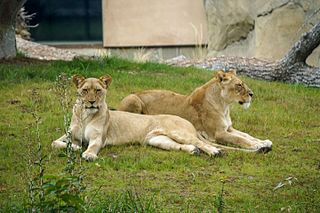
The Fresno Chaffee Zoo is a zoo in Roeding Park in Fresno, California covering 39 acres and housing over 190 species. Its attractions include Stingray Bay, Dino Dig, Valley Farm, Sea Lion Cove, African Adventure, and Ross Laird's Winged Wonders Bird Show. The zoo is accredited by the Association of Zoos and Aquariums (AZA) and is a member of the World Association of Zoos and Aquariums (WAZA).

Denver Zoo is an 80-acre (32 ha) nonprofit zoological garden located in City Park of Denver, Colorado, United States. Founded in 1896, it is operated by the Denver Zoological Foundation and funded in part by the Scientific and Cultural Facilities District (SCFD) in addition to ticket sales and private donations. It is the most visited paid attraction in Colorado.
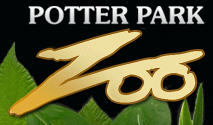
The Potter Park Zoo is a 102-acre (41.3 ha) zoo located in Lansing, Michigan, within Lansing's Potter Park. Its mission is to Inspire people to conserve animals in the natural world. Potter Park Zoo is the oldest public zoo in Michigan and is currently home to over 160 species of animals. The zoo is owned by the City of Lansing, and operated by Ingham County. The zoo participates in the Association of Zoos and Aquariums (AZA) Species Survival Plan (SSP) designed to manage and conserve threatened or endangered animals. The Michigan State University College of Veterinary Medicine partners with the zoo to provide medical care for its animals.

The Potawatomi Zoo is a 23-acre (9.3 ha) zoological park located in South Bend, Indiana, United States. The zoo is nestled in Potawatomi Park between the St. Joseph River and the Grand Trunk railroad in the east side neighborhood of River Park. Founded in 1921, it is Indiana's second-oldest zoo. It features over 400 animals and is accredited by the Association of Zoos and Aquariums. The zoo has over 200,000 visitors each year.

The Toledo Zoo & Aquarium, located in Toledo, Ohio, is a member of the World Association of Zoos and Aquariums (WAZA) and is accredited by the Association of Zoos and Aquariums (AZA), valid through September 2023. The Toledo Zoo & Aquarium houses over 10,000 individual animals from 720 species. The Toledo Zoo & Aquarium currently participates in over 80 species survival programs. It has over 57,000 members and hosts over 1 million visitors a year.

The Texas State Aquarium is a nonprofit aquarium located in Corpus Christi, Texas, United States. It aims to promote environmental conservation and rehabilitation of the wildlife of the Gulf of Mexico. It has been accredited by the Association of Zoos and Aquariums (AZA) since 1995. It is the largest aquarium in Texas and one of the largest aquaria in the United States.

Sydney Zoo is a zoo in Bungarribee in the Western Sydney Parklands, in Greater Western Sydney, New South Wales, Australia. Sydney Zoo is located 38 kilometres (24 mi) west of the Sydney central business district. It occupies a 16.5-hectare (41-acre) site. Sydney Zoo is a member of the Zoos and Aquariums Association of Australia and New Zealand.



